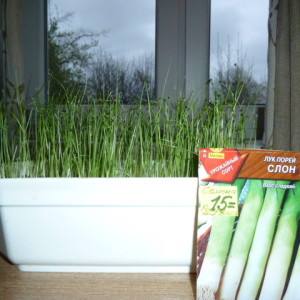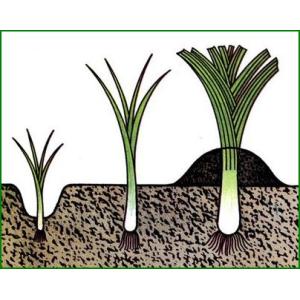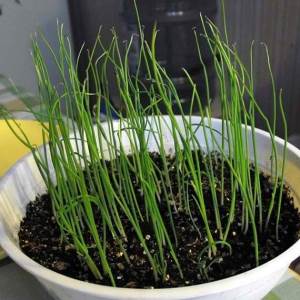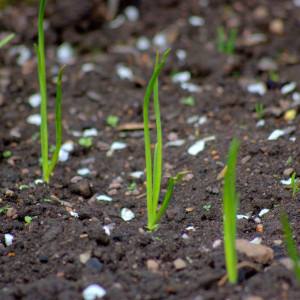Features of growing onions from seeds
Growing onions from seeds traditionally consists of several stages. In the first year, seeds are sown, the so-called chernushka, to obtain onion sets, from which full-fledged large bulbs already grow in the second year.
But this long process can be significantly accelerated and a high-quality harvest can be obtained in just one season, using a method that is gaining popularity among gardeners. Consider all the features of growing onions from seeds in different ways.
The content of the article
What are the advantages of seed growing
When compared to the bulb method, sowing with seeds has several advantages:
- Reduced costs. Seeds are cheaper, and the yield obtained from them is better stored.
- You can grow a full-fledged onion in one season, even without seedlings, if you choose the right variety and planting time. An additional condition is favorable weather.
- Safety. If you come across low-quality onion set material, various diseases can be introduced into the soil. Potassium permanganate treatment does not always help. It is much safer, faster and easier to pickle seeds.
- Increased productivity. If the sevka bulbs are of poor quality and give poor germination, many voids will form. And seedlings from seeds can be thinned evenly, creating the necessary gaps.
What are the disadvantages
The main disadvantage is that more maintenance is required for onion seedlings.
- Shelter needed. With early sowing, seedlings may be threatened by recurrent frosts. Even heavy rainfall can damage crops by simply washing them off the garden bed before they take root.
- Weeding. Weeds are the main threat to seedlings. They can destroy seedlings if they are not removed in time. It is necessary to polish carefully - there is a threat to pull out a young onion along with weeds, since its roots are still weak.
- Thinning. It is imperative to remove weak plants to make room for stronger seedlings.
To an experienced gardener, these disadvantages will not seem significant - this is an integral part of the agricultural technology of any vegetable that is grown by seeds.
Growing methods
There are three main ways:
- biennial;

- winter sowing;
- turnip onions in one year.
The first method is too time-consuming. First, onion sets are grown, and the next year, marketable onions are grown from it. It has a significant drawback - at the intermediate stage, it is important to properly store the small onion bulbs.
If stored improperly, changes will occur in them that will affect the quality of the final crop. There is a danger that in the second year such a bow will all go into the arrow.
The second method - before winter, nigella is sown on previously prepared beds. Planting densely - there is a possibility that not all seeds will germinate.
Advice! Make the bed for winter planting raised, then it will warm up better in spring. When the snow melts, it will settle down a little.
The third method is spring sowing. You can sow nigella directly into the ground in early spring, when the snow has melted and the soil has warmed up. Or sow on seedlings in a greenhouse or in containers at home. With the seedling method, an additional 1.5-2 months is gained, which may not be enough for the culture to mature when planting directly into the ground.
How to choose the right variety
If the goal is to harvest onions in one season, then the variety should be:
- early or mid-early - ripening times should not exceed 110 days when sown in the ground;
- small-germ - forming one large bulb, and not several;
- resistant to diseases - in particular, to peronosporosis (downy mildew);
- resistant to unfavorable growing conditions.
Choose the size and taste of the variety at your discretion.
The best varieties for annual cultivation
Consider the time-tested varieties domestic and foreign selection, possessing the necessary qualities, suitable for sowing in our latitudes.
- Shaman - elongated red-brown bulbs, pink inside, weighing 50-65 g, ripen early. It is better to grow through seedlings. A productive variety, easily tolerates drought and high planting density.

- Centaur - Light yellow round bulbs reach a weight of 100 g when planted in the ground. Their mass can reach 200-300 g if planted with seedlings. It will remain excellent until spring.
- Exibition - golden, large bulbs grow up to 500 g. Formed in one season, can be planted by direct sowing into the ground, without seedlings. A salad variety of Dutch selection, high-yielding. It is not stored for long, until mid-winter.
- Red Baron - cherry-colored onions, up to 100 g, with a spicy taste. It is sown in the ground, easily tolerates any weather conditions, ripens in 110 days, is well stored.
- Agro winter - dense, rounded white, up to 100 g. The best variety for winter planting.
- Karatalsky - flat-rounded golden onions weighing about 100 g. Early maturing, disease-resistant, fruitful and well stored.
- Siberian annual - an early variety that can be planted before winter, as it is resistant to cold weather. Gives a good harvest, has a long shelf life, resistant to shooting.
The following varieties have also proven themselves excellent: Myachkovsky, Strigunovsky and Odinovets.
When to collect nigella seeds
Collecting seeds begins when single cracked bolls appear in the umbrellas. Since they ripen at different times, so as not to miss the moment and not to lose them, experienced gardeners advise tying the inflorescences with gauze. Or cut them off at the end of flowering and leave in a dry, well-ventilated area for several weeks to ripen.
Technology of growing onions from seeds
To get a bountiful harvest, stick to proper farming practices.
When is the best time to plant
Planting dates depend on the variety and growing method:
- winter plantings are carried out in the fall, two weeks before the onset of cold weather;
- seedlings are sown in the last days of February or at the beginning of March;
- spring sowing in the ground is carried out from mid-April.
Experienced gardeners are advised to focus on the weather and the lunar calendar. Therefore, planting dates can shift in one direction or another from several days to two weeks.
Soil preparation
The planting site should be sunny, without trees growing nearby and shade from tall buildings. The earth can be of any composition, the main thing is to grind it thoroughly, since onions are the most demanding crop for tillage.
Because the roots of the onion are shallow, they are responsive to fertilization. When digging, land is applied per sq. m 3 kg of peat or 5 kg of rotted compost. You can also add 1 tbsp. l. nitrophosphate and superphosphate.
Important! For onions, they choose areas where they used to grow: potatoes, tomatoes, cucumbers, legumes, since they enrich the land with nitrogen. And it is returned to its original place no earlier than four years later.
Garden beds
The optimal width of the beds is 0.8-1 m, the height is 15-20 cm. All introduced components must be thoroughly mixed, ground and carefully leveled.

Preparation of seeds and planting material
First, the largest seeds are selected. They are checked for germination, for which 10 pieces are put on a damp cloth for two weeks. If less than seven of them hatch, this is a bad indicator. Take another batch of seeds.
Then the nigella is etched in a weak solution of potassium permanganate to disinfect and soaked in warm water for a day.
Before planting, the seedlings are placed in a container with water in order to release the roots without damage. Then the roots and stems are cut by a third and planted in this form.
Landing scheme and rules
Before planting, grooves are made up to 2 cm deep and their bottom is compacted. The distance between the furrows is about 5 cm.
Spread the seeds evenly and cover with a layer of compost or loose earth. Then the bed is shed and covered with a film until shoots appear.
Advice! Nigella merges with the ground, but you can mix the seeds with chalk and then it will be noticeable with what frequency they are sown.
When planting ready-made seedlings, they are evenly distributed over the bed with an interval of 10 cm between the plants - so there is no need to further thin out the plants. When planting large varieties of onions, it is better to adhere to the 25x25 cm scheme.
Care
Taking care of growing onions is easy. Let's review the main steps below.
Weeding
The growing seedlings must be freed from weeds. If weeds are not cut out, they will drown out the sprouts and prevent them from developing normally. In this case, the harvest will be cut in half.
When the seedlings reach 5-7 cm, they need to be thinned out. In total, three thinnings are required, they do this at an interval of 2-3 weeks.
Watering
Watered onions until mid-June 1-2 times a week, depending on the weather. Watering is stopped about a month before harvesting.
Top dressing
If onion growth is delayed, it is spilled with a urea solution at the rate of 4 liters per sq. m. It is prepared like this: 1 tbsp. l. fertilizer is stirred in a bucket of water.
Protection against diseases and pests
It is best to fight pests and diseases with modern drugs that are sold in specialized stores.
Harvesting
When the foliage of the onion begins to turn yellow and dry out, they are harvested in dry weather. It is carefully dug up and dried in the sun for about two weeks.
After harvesting, the crop is sorted. Larger bulbs are sent for long-term storage, medium and not quite ripe ones are eaten first, and small ones (sets) are left for planting next year.
Conclusion
Observing the technology and taking into account the peculiarities of growing onions from seeds, you will get an excellent result. It is important to choose the right planting method, the right variety and care for the crops. A rich harvest!